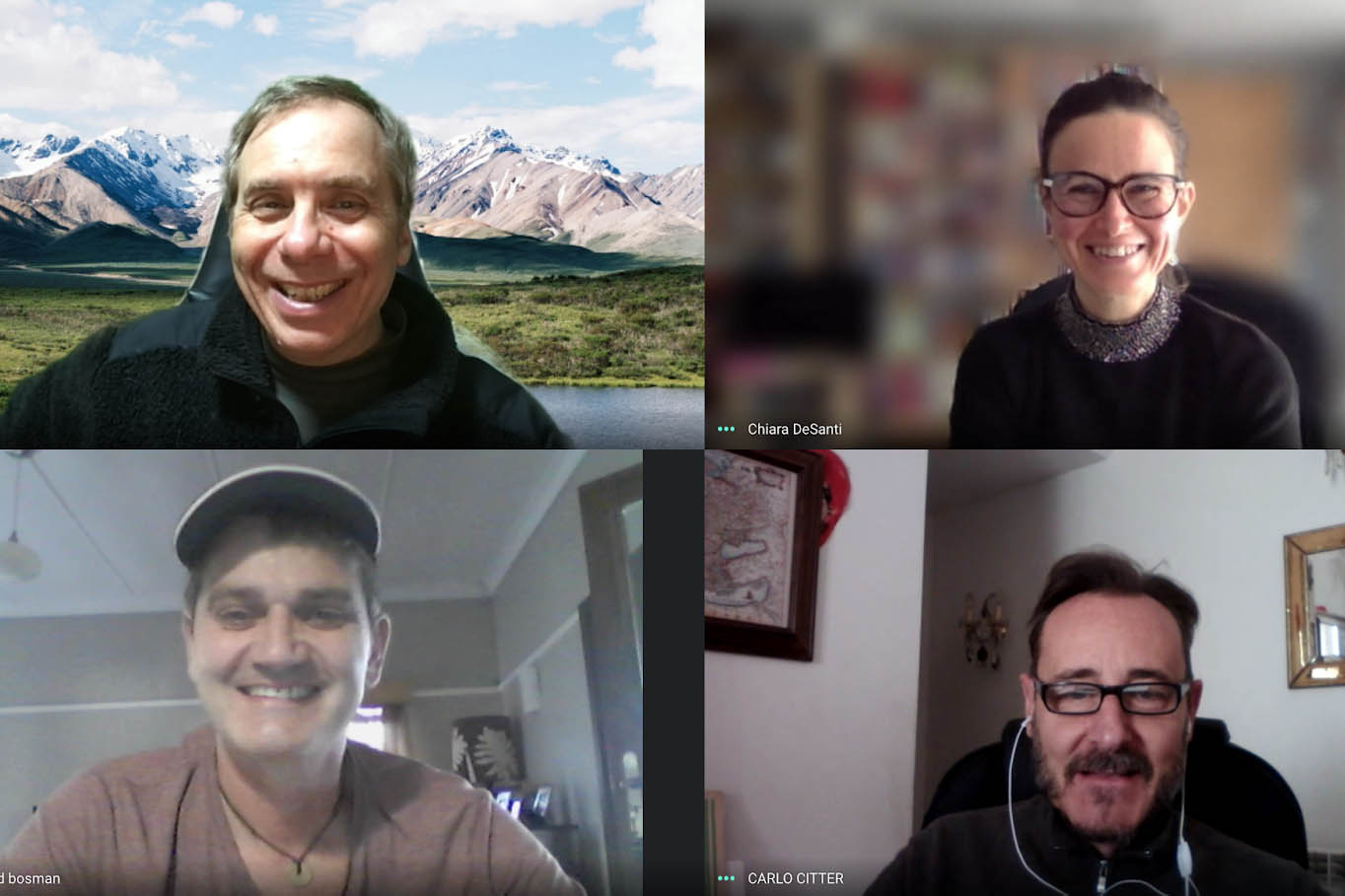16 July 2021
|
Story Leonie Bolleurs
|
Photo Supplied
 According to Prof Gerhard Bosman (bottom left), the biggest advantage of the COIL exchange for Architecture students was their cultural and online collaboration development while addressing urban diversity, multiplicity, and complexity in the built environment. During an online engagement between academics, were from the left: Prof Mark DeBoer and Prof Chiara De Santi; and bottom, right: Prof Carlo Citter.
According to Prof Gerhard Bosman (bottom left), the biggest advantage of the COIL exchange for Architecture students was their cultural and online collaboration development while addressing urban diversity, multiplicity, and complexity in the built environment. During an online engagement between academics, were from the left: Prof Mark DeBoer and Prof Chiara De Santi; and bottom, right: Prof Carlo Citter.
In South Africa, student exchange programmes – especially at undergraduate level – remain extremely limited. The national
Policy Framework for Internationalisation of Higher Education in South Africa, however, makes internationalisation of the curriculum mandatory and directs that it ‘must not negate curriculum transformation imperatives which higher education institutions in South Africa have an obligation to fulfil'.
The University of the Free State (UFS), through its
Office for International Affairs, coordinates the
iKudu project, which seeks to transform curricula through internationalisation and virtual exchanges. iKudu, a Capacity Building for Higher Education (CBHE) project, is funded by the European Union’s Erasmus+ programme with EUR999 881 (approximately R20 million) and is implemented over a three-year period. Partner universities in the project are the South African Central University of Technology, Durban University of Technology, University of Limpopo, and University of Venda, with the University of Antwerp, Amsterdam University of Applied Sciences, The Hague University of Applied Sciences, Coventry University, and the University of Siena the European partners in the project.
The dream
According to
Cornelius Hagenmeier, Director of the UFS Office for International Affairs, at least 50 academics and 5 250 students from South Africa and Europe will participate in the project through the collaborative online international learning
(COIL) exchange model. Academics are receiving training on accredited courses in a virtual setting where the classrooms (each located in a different country or cultural setting) of two or more higher education institutions are linked, working with colleagues from partner universities to implement COIL virtual exchanges for the benefit of their students.
He says: “Students with different cultural and geographical perspectives and experiences have the opportunity to learn from each other through cross-cultural dialogue, bringing a global dimension to the course content. Apart from developing the intercultural competence, technological skills, and the ability to work in groups, students also enhance their employability.”
Another major advantage of this model is that it gives effect to the South African Policy Framework by contributing to internationalisation at home through purposeful integration of international and intercultural dimensions into the formal curriculum.
Hagenmeier believes that, besides a transformed curriculum at all partner universities, this process will also influence policy development at national and regional level.
The opportunity
BArchHons students from the History of Urban Settlement module in the
UFS Department of Architecture are but one example of a group of students who benefited from the exchange programme. UFS associate professor and researcher in Earth Architecture,
Prof Gerhard Bosman, collaborated with academics from Italy, Japan, and the USA to engage with 85 students across four continents.
From the University of Siena, Italy,
Prof Carlo Citter, an associate professor in Medieval Archaeology, participated in the programme. He was joined by
Prof Mark deBoer, a lecturer from the English for Academic Purposes (EAP) programme at the Akita University in Japan, and
Prof Chiara De Santi, an assistant professor of Modern Languages, teaching film and cultural courses in English and Italian at the Farmingdale State College in the USA.
Prof Bosman says the COIL exchange programme, which started on 12 April 2021, was executed in three parts. He shares his account of the nine-week journey: “After students introduced themselves on Padlet, they were divided into twelve teams to collaborate in groups of seven to eight students (while creating a digital presence on Google Drive) to discuss, explore, and reflect on the urban environment and the portrayal of society during war/the aftermath of a war as depicted in a selected main steam film. Six weeks later, the groups had to submit final video and slide presentations on these topics. In the last part of the exchange programme – where students benefited from the perspectives of academics in four different cultures – a group and individual assessment reflecting the course discipline of the four student groups had to be accommodated.
Overcoming challenges
The process unfortunately also had its challenges. Due to the time difference at most of the institutions, students found it difficult to meet. They also had to overcome the language differences, since not all students at the four institutions were English first-language speakers. However, the use of Google Meet (an online tool) with its English caption function helped individuals to follow the text from English voices.
As academics and students worked through the challenges, Prof Bosman confirmed that the COIL exchange programme has significant advantages. He states that the biggest advantage of the COIL exchange for Architecture students was their cultural and online collaboration development while addressing urban diversity, multiplicity, and complexity in the built environment.
A follow-up COIL exchange between the four new partner universities in 2022 is well underway in the development and planning phases.